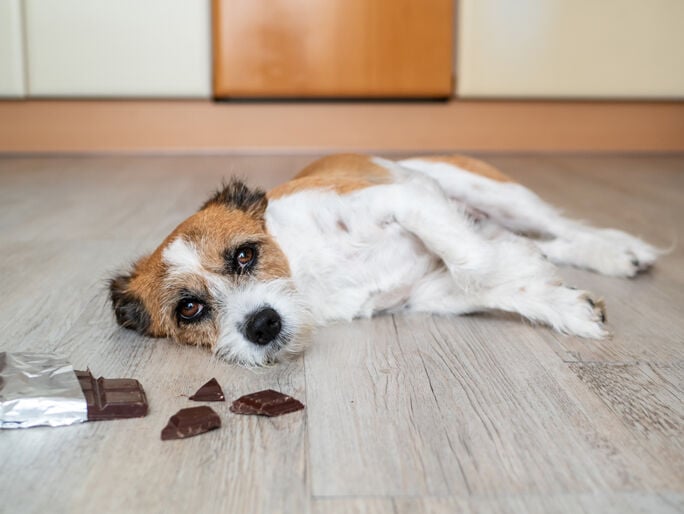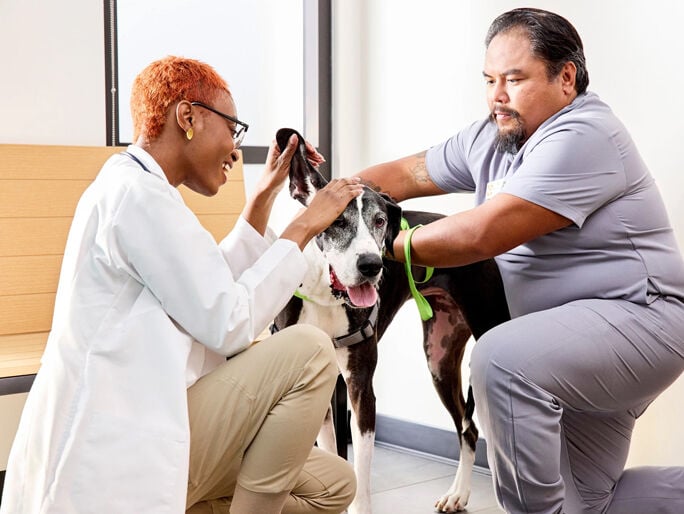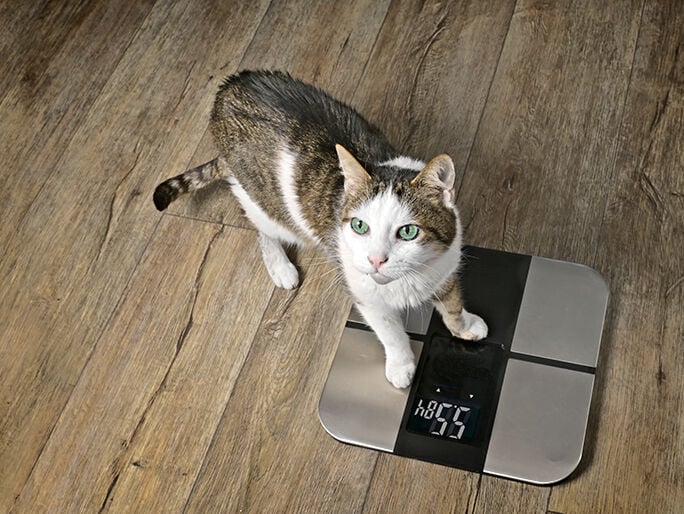how to feed your dog
From puppy snacks to feeding your senior dog, meals are the foundation of your dog’s health.
Your dog’s diet affects their well-being, physical appearance, and even their quality of life.

Quality dog foods include:
- Proteins
- Critical carbohydrates
- Dietary fiber
- Dietary fats
- Vitamins and minerals
- Water
- No more than 10% of their calories in treats

7 signs of digestive health problems in dogs
- Sudden weight loss or gain
- Excessive thirst
- Behavior changes
- Vomiting, diarrhea, or constipation
- Loss of appetite
- Eating difficulties
- Painful abdomen
The ultimate dog-feeding guide
Sorting through pet food information can feel like a lot. Luckily, no one ingredient is essential for dog health! There are many ways to deliver quality nutrition for your pet.
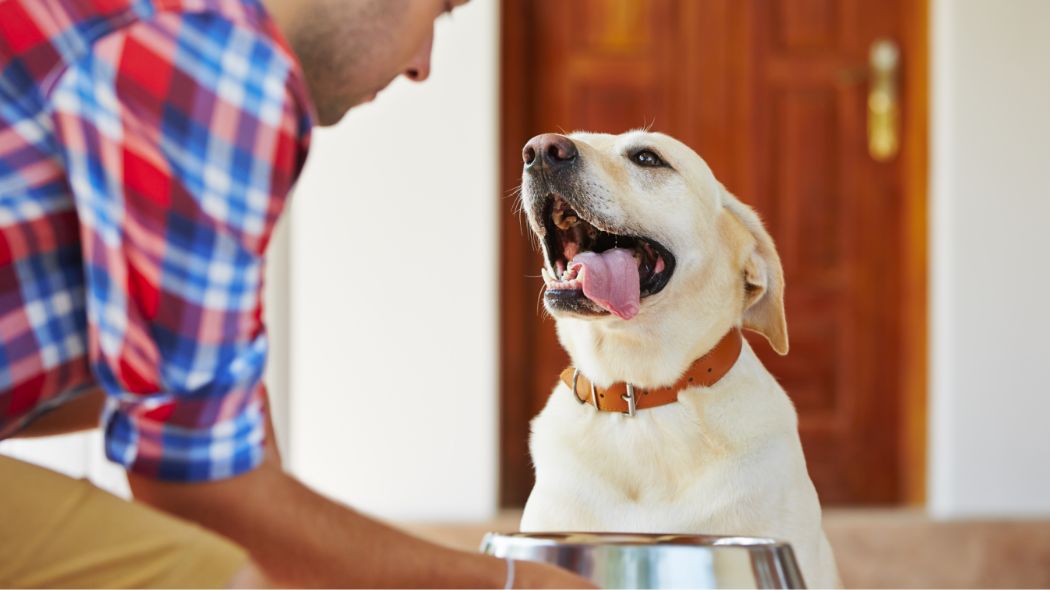
Nutrition is the foundation of a quality dog diet
Your dog doesn’t just need a certain amount of food. They also need the right kind of food, one that delivers quality nutrition in the right proportions for your dog’s health.
When your dog gets the right nutrients, it helps their system stay in balance. All the good stuff in their food gets broken down to help power muscles, process oxygen, create new blood cells, build up bone and tissues, and support vision and hearing.
How dogs digest food
Inside your dog is a digestive system completely devoted to breaking down food into fuel for life and everything from tail wagging to zoomies to biiiiiiiig post-nap stretches.
Digestion begins in the mouth through chewing and saliva which initiates the first stages of food breakdown and softening. Next, food moves into the large and small intestines, which are coated with cells designed to absorb nutrients like protein, vitamins, minerals, fats, and carbs. Also inside the intestines are a kind of good bacteria or microflora, that breaks down the food, as well as other cells that work to fight off bacteria that can disrupt the digestive process. (This is where nutrients like probiotics, which support healthy microflora, come in.)
As digestion continues, nutrients are shuttled to fuel different parts of your dog’s body. One important process involves a hormone called insulin which moves blood sugar (glucose) into cells that need it for fuel. When this process breaks down, it results in a metabolic disease called diabetes.
After the useful stuff is pulled out in the digestive process, your dog poops out what’s left as waste material.
How to know if your dog has food intolerances and/or food allergies
Sometimes pets will have a reaction to or are unable to digest certain ingredients in their food. If this response involves the immune system, your pet may become incredibly itchy or develop an ear infection. If it’s an intolerance, they may vomit or have diarrhea.
Remember to consult your veterinary team if your dog is showing physical or digestive distress.
Bring them in to a Banfield hospital near you if you spot the following symptoms:
- Sudden weight loss or gain
- Itching
- Ear discomfort
- Excessive thirst
- Behavior changes
- Vomiting, diarrhea, or constipation
- Loss of appetite
- Difficulty eating
- Painful abdomen
- Poor skin or coat
How to help your puppy, adult, or senior dog with nutrition
Your dog’s nutritional needs change depending on the stage of their life. We recommend puppies eat specially formulated puppy food to help them grow, while adult and senior dogs may need special diets to support their health as they age.
Reading pet food labels is one way to evaluate if your pet is getting the nutrition they need — but it can be a bit tricky. Nutrients in pet foods are seldom listed in their pure form, but rather come bundled as part of more complex ingredients.
It can help to know that quality dog food isn’t about a brand, label, or even specific ingredients.
Simply put, a quality food is formulated to supply key nutrients in the right balance for your pet’s species, age, and stage of life.
-
Critical carbohydrates, including prebiotics:
Give your dog quick energy, while prebiotics help support their gut flora to break down food.
-
Proteins:
Supply amino acids that power cell growth and replacement.
-
Dietary fiber:
Helps the intestines function for healthy poops.
-
Dietary fats:
Provide an energy source and support nerve function.
-
Vitamins and minerals:
Contribute to different healthy processes in your pet’s body.
-
Water:
Should be fresh, clean, readily available, and is super important for pet health.
What’s the difference between commercial wet and dry dog foods?
Both wet and dry dog food can deliver quality nutrition for your dog. It’s purely a matter of personal preference. However, because wet dog food holds more water, it delivers fewer nutrients per ounce than dry food. This means your doggo needs to eat — and process — more of it per meal to get the same nutritional load. And because wet food doesn’t take much work to chew, it doesn’t do much to help keep teeth clean and healthy.
Since many dogs enjoy the nice moist mouth feel of wet food, supplying a mix of wet and dry can combine the best of both worlds. Some dry foods can also help with oral health — ask your veterinary team!
What times should adult dogs be fed in the morning or the evening?
There is no single time that works best for feeding adult or senior pets. (Feeding puppies has different rules: see below.)
One common pitfall in feeding dogs is free-feeding, which can easily lead to obesity. If you like to leave out food so your dog can snack throughout the day, stick to their recommended calorie count. Even if your dog complains, they do not need a refill every time they’ve cleared their bowl.
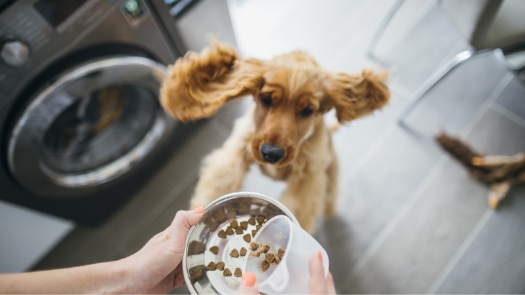
How often should I feed my puppy?
Consult with your veterinary team about your unique puppy BFF! Depending on their size and breed, puppies need their calories delivered in multiple small meals, sometimes up to eight small meals a day.
Puppies also need a specific puppy diet designed to support their cute furry bodies as they grow. They may also have breed- or size-specific calorie needs.
Talk to your veterinary team about the right time to switch your pup to adult dog food. Since adult food doesn’t present the same nutrients in the same forms, it’s easy for a puppy’s system to get out of order if they start on adult food too soon.
Senior dogs may need special diet support
No matter your pet’s age, keep an eye out for digestive issues like diarrhea or vomiting and mention them to your veterinary team. You may need to change your dog’s diet several times during their life depending on their physical needs.
As your dog gets older, their gut flora changes. They can also develop certain health issues that may require special diets or prescriptions.
How much should I feed my dog? What about dog treats?
How much and how often you feed your dog will depend on your dog’s age, size, breed, and lifestyle, if you’re using diet to manage diabetes or obesity, or if you’re feeding them wet or dry food.
One basic guideline is to look at the recommended serving sizes on quality commercial wet or dry dog food, which should supply calorie counts and suggested serving sizes based on your pet’s ideal weight. Then double-check this number with your veterinary team and see how your dog responds to the diet. If they get too heavy, you might need to decrease the amount; if they lose weight, you may need to add more.
If you like to give your dog treats — and who doesn’t? — remember the 10% rule: Treats should only be about 10% of your dog’s daily calorie count.
But — always avoid people foods or table scraps. Human foods are just too high in calories and fat for dogs, and can lead to unfortunate side effects like obesity, stomach upset, and toxic (to the rest of the family anyway, lol) farting.
What’s the “best” way to change to a new dog food?
Many owners find out the hard way that dog digestion suffers when they eat something new. So, if you’re switching up your dog’s food, the trick is to do it slowly.
The general guideline is to start at the beginning of the week with 75% old food and 25% new food. Then gradually increase the percentage of new food each day.
By the time your dog has reached 100% of the new food in their food bowl, they should be happily eating (and pooping) their nice, new meals.
If they show digestive distress, please reach out to your veterinary team right away.
Mentioned in this article

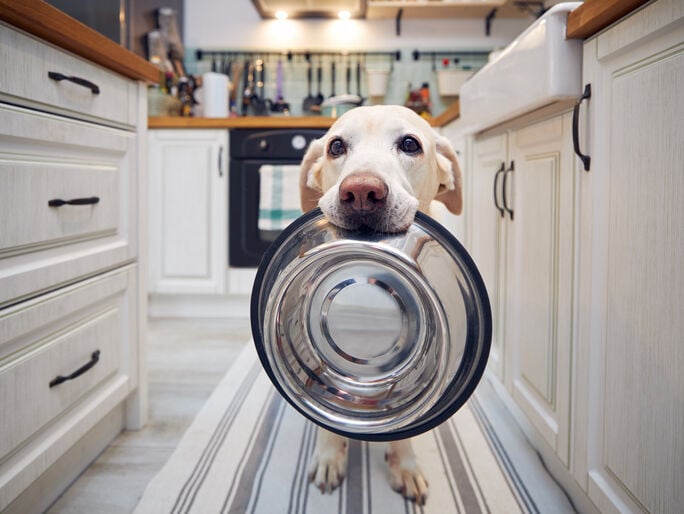
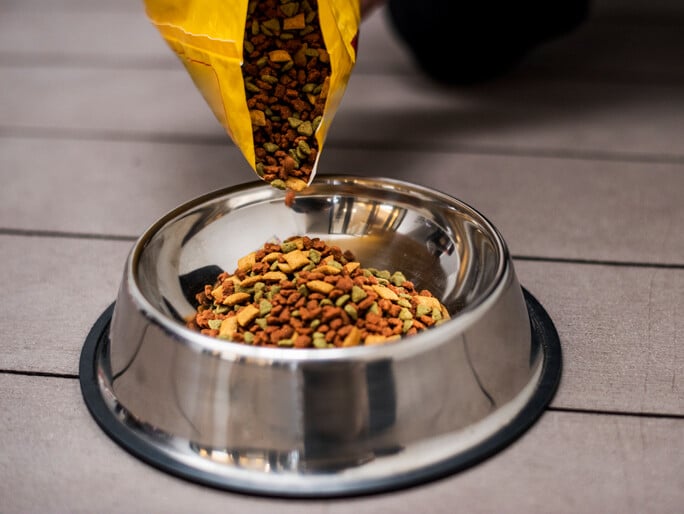

Need advice on flea control? Ping Pet Chat™!
Whether it's 3 a.m. or 3 p.m., connect with a real veterinary professional for immediate petcare advice. It's included in all Optimum Wellness Plans®!
Log in to start chattingHow Banfield can help with dog and cat diet and nutrition
What your pet eats can make a big difference to their health! Our vets can perform physical exams, run tests, and help you manage your pet’s food-related issues, including obesity, diabetes, and food allergies.

Get help managing pet food allergies. Do you think your pet’s immune system is reacting to certain ingredients in their food? We can help identify pet food allergies and work with you on management diets.
Does your pet have diabetes? Let’s work together! This includes everything from recommendations on what to feed your pet, how to manage their food and injection schedule, providing appropriate prescriptions, and showing you how to safely perform insulin injections for the pet you love.
We can help your pet reach a healthy weight. We've got advice on diet and exercise for both overweight and underweight pets. Does your pet have a mobility issue that makes it hard for them to exercise? We can help there, too.
 Mites and mange
Mites and mange Podcast - Not Just Fluff
Podcast - Not Just Fluff

